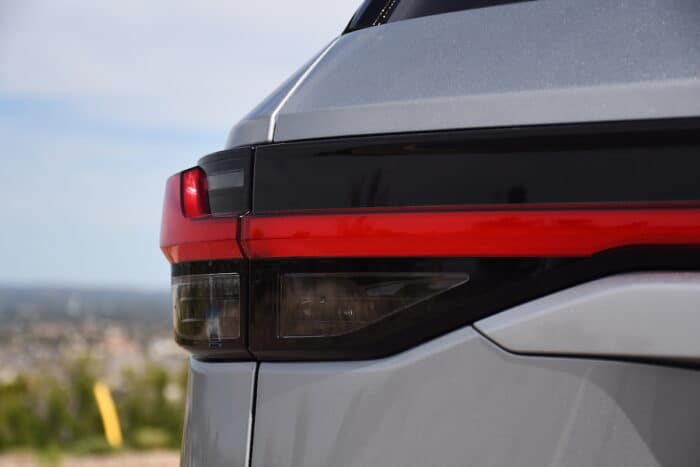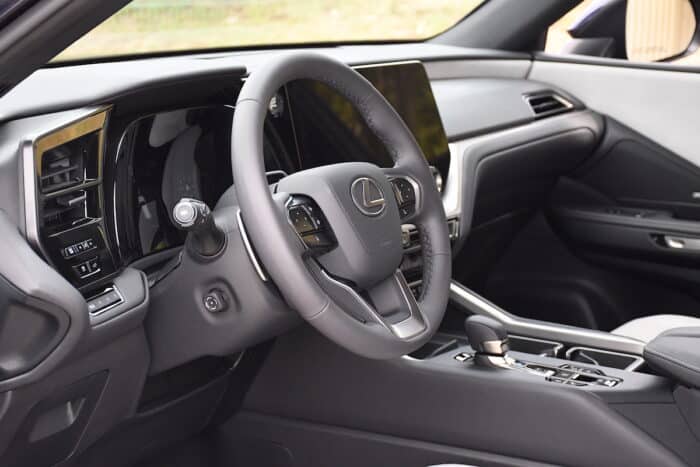Austin, Texas — Lexus adds another SUV to its lineup in 2024 with the stylish new TX. It slots between the RX and the brand’s two larger SUVs, the GX and LX, expanding Lexus’ three-row SUV offerings to three models, a first in the industry. The critical difference is that the TX is built on a monocoque structure, whereas the other two rest on ladder frames for more capabilities, whether for towing or off-road driving. The TX is more urban and sophisticated.

As the upscale cousin of the Toyota Grand Highlander, the TX offers more refinement and introduces a plug-in hybrid variant (TX 550h+) not found with its Toyota counterpart. It also has a base version (TX 350) and a hybrid option (TX 500h).
In this comprehensive review, we cover:
- Exterior styling
- The adult-size 3rd-row
- Engine options
- Fuel economy (mpg & L/100km)
- Price list (US and Canada)
- Interior equipment & tech
- Driving impressions
- Takeaway (pros & cons)
- Specs & images
Here are some previous Lexus TX resources as well:
- All 3 Lexus TX 2024 Models You Need to Know About
- 2024 Lexus TX Release Date, Price & Preliminary Specs: Here’s What We Know
- SUV Comparo: The Toyota Grand Highlander Vs. Lexus TX
A Bold and Controversial Style

Regarding style, recognizing the new TX won’t be difficult, mainly because of its front end. Lexus finds unique ways to reinvent its spindle-shaped grille; with this TX, it stands out. It won’t please everyone, but it has the merit of being distinctive.

For the rest, it’s much more mainstream and traditional. The all-black D-pillar adds to the roof’s floating impression, gently sloping backward; the desired effect is spot-on but varies depending on the chosen body colour. At the rear, it’s much more attractive with taillights that span the width and visible Lexus lettering, a lovely touch of elegance. The 20 or 22-inch wheels add to the model’s prestige.
Seven Proper Seats
The focus has been put on space and comfort, which is not surprising. The TX has effectively replaced the RX-L in the lineup. The latter never stood out with its cramped third row and a lackluster cargo volume of 1,656 liters.


TX cargo space
The TX introduces a more spacious and easily accessible third-row bench. The cargo volume is substantial at 2,747 litres behind the first row, the most generous in its category, surpassing rivals like the Acura MDX (2,690 litres) and Infiniti QX60 (2,135 litres), two of the TX’s direct competitors.
| Spec | TX 350, TX 500h, TX 550h+ |
|---|---|
| Cargo space behind the third row | 20.1 cubic feet (569 L) |
| Cargo space with third row folded flat | 57.4 cubic feet (1,625 L) |
| Cargo space with second row folded flat | 97 cubic feet (2,747 L) |
Quality is evident in the choice of materials and the precision applied to their assembly. We’ll delve into the equipment details of the versions a bit further on.
Three Models, Three Powertrains

Each TX offers its powertrain and gearbox. The TX 350 model is powered by a 2.4L turbocharged 4-cylinder engine generating 275 horsepower and 317 pound-feet of torque. It’s paired with an 8-speed automatic transmission.
The TX 500h model inherits the same engine but benefits from the support of two electric units, one at the front and one at the rear. This setup provides a combined power of 366 horsepower and a torque of 409 pound-feet. This version has a 6-speed automatic transmission and uses Lexus’s Direct4 system for all-wheel drive. Its torque distribution can vary from 100:0 (front/rear) to 20:80 instead of the 50:50 maximum of the TX 350 version.

Finally, the TX 550h+ model stands out with a 3.5L V6 producing 406 horsepower (combined torque not provided). A continuously variable automatic transmission and the Direct4 system manage the power distribution to all four wheels. What makes this version unique is its electric range of 53 km. Here’s a look at all three TX powertrains:
TX 350
| Spec | Details |
|---|---|
| Engine | 2.4L Turbo Gas |
| Horsepower | 275 hp |
| Torque | 317 lb.-ft |
| Transmission | 8AT |
| Drivetrain | FWD/AWD |
| Fuel Economy (city & hwy combined) | 21 mpg (11.2 L/100 km) |
TX 500h
| Spec | Details |
|---|---|
| Engine | 2.4L Turbo Hybrid |
| Horsepower | 366 hp |
| Torque | 409 lb.-ft |
| Transmission | 6AT |
| Drivetrain | DIRECT4 AWD |
| Fuel Economy (city & hwy combined) | 24 mpg (9.8 L/100 km) |
TX 550h+
| Spec | Details |
|---|---|
| Engine | 3.5L V6 Plug-in Hybrid |
| Horsepower | 406 hp |
| Torque | – |
| Transmission | CVT |
| Drivetrain | DIRECT4 AWD |
| Fuel Economy (city & hwy combined) | 30 mpg, 31 mi. EV range (7.8 L/100 km, 53 km. EV range) |
On the Road: A Gentle Driver Not Meant To Be Pushed Hard

Speaking of road behaviour, let’s get into it. I had the opportunity to drive the TX 350 and TX 500h variants (the TX 550h was missed due to scheduling constraints). With both, you find the qualities expected from a Lexus product: comfort, smooth ride, excellent soundproofing, and a reassuring driving experience. In terms of power, the TX 350 model offers enough.
The TX is heavy (nearly 5,000 pounds for the hybrid version), and it shows when you push it a bit too hard.
Still, those who appreciate performance will be delighted with the TX 500h version, which is better balanced overall. The lightness of the steering, especially with the TX 350 model, is an appreciated feature, especially at low speeds. The hybrid model’s rear steering wheels also facilitate maneuvers in tight spaces.
Forget any sportiness, though; despite its nice balance, the TX is heavy (nearly 5,000 pounds for the hybrid version), and it shows when you push it a bit too hard. Anyway, this is the kind of vehicle you appreciate when you drive it gently. In this regard, the TX delivers the goods.
Lexus TX Fuel Economy Ratings
As for fuel efficiency, the TX 350 all-wheel drive model has ratings of 20 mpg in the city (or 11.5 litres per 100 km in the city) and 26 mpg on the highway (or 8.9 litres on the highway), averaging 23 mpg (10.3 litres). Below are the official manufacturer-estimated fuel 2024 TX fuel consumption ratings in both mpg and litres:
TX 350 (AWD):
| Spec | MPG | L/100km |
|---|---|---|
| City | 20 mpg | 11.5 L/100km |
| Highway | 26 mpg | 8.9 L/100km |
| Combined | 23 mpg | 10.3 L/100km |
TX 500h (AWD):
| Spec | MPG | L/100km |
|---|---|---|
| City | 27 mpg | 8.7 L/100km |
| Highway | 28 mpg | 8.4 L/100km |
| Combined | 27 mpg | 8.6 L/100km |
TX 550h+ (AWD):
| Spec | MPG | L/100km |
|---|---|---|
| City | 29 mpg | 8.1 L/100km |
| Highway | 28 mpg | 8.4 L/100km |
| Combined | 29 mpg (33 mi. EV range) | 8.1 L/100km (with 53 km EV range) |
2024 Lexus TX Price and Models Across North America

Now, let’s talk about the price range—the entry-level TX 350 starts at $55,050 in the US and $68,750 in Canada. Only the TX 500h gets the F Sport treatment, starting at $69,350 (in Canada, the TX 500h model is available only with the F Sport 2 and F Sport 3 trims, priced at $84,200 and $90,200, respectively).
As for the TX 550h+ model, which will only be available in the all-inclusive Executive configuration, the price will be announced when the model arrives at dealerships a bit later. It should be below the $100,000 mark to avoid the luxury tax, depending on where you live.
| Model (United States) | Starting MSRP (USD) |
|---|---|
| TX 350 FWD | $55,050 |
| TX 350 Premium FWD | $58,450 |
| TX 350 Luxury FWD | $60,950 |
| TX 350 AWD | $56,650 |
| TX 350 Premium AWD | $60,050 |
| TX 350 Luxury AWD | $62,550 |
| TX 500h F SPORT | $69,350 |
| TX 500h Performance Premium AWD | $72,650 |
| TX 500h Performance Luxury AWD | $78,500 |
| Model (Canada) | Starting MSRP (CAD) |
|---|---|
| TX 350 Luxury | $68,750 |
| TX 350 Ultra Luxury | $71,500 |
| TX 350 Executive (7 passengers) | $79,500 |
| TX 350 Executive (6 passengers) | $80,250 |
| TX 500h F SPORT Performance 2 | $84,200 |
| TX 500h F SPORT Performance 3 | $90,200 |
The Lexus TX Interior and Equipment
We’ll skip a tedious description of the complete equipment of each model and focus on the essentials to give you an idea of what’s offered from one variant to another.

The TX offers a seven-seat layout in the base configuration and many features, including a 12-speaker audio system, a panoramic roof, heated and ventilated front seats, and heated second-row seats. Lexus’s multimedia system screen measures 14.4 inches and offers a modern, user-friendly interface.

The Ultra Luxury variant gives the driver a 12.7-inch information display, and the interior features ambient lighting. With the Executive version (six or seven seats), the TX reaches its peak, adding a Mark Levinson 21-speaker audio system, a heads-up display, and additional safety features. This version can also have a six-seat interior featuring heated and ventilated captain’s chairs in the second row.

The hybrid versions are only available with one of the two F Sport packages (2 and 3). They stand out for their unique style, but most importantly, the presence of an adaptive variable suspension and rear-wheel steering. The rear wheels turn (four degrees) in the opposite direction of the front wheels at low speeds and in the same order at high speeds, all for greater maneuverability. However, one disappointing detail about this TX 500h model is that it’s only available with a six-seat interior. On the other hand, its road behaviour is more interesting.
Takeaway
Pros:
- Complete safety system with the LSS 3.0 (Lexus Safety System) and more features offered as you climb the grade
- Excellent ride and comfort
- Predicted reliability
Cons:
- No seven seated configurations with the TX 500h
- You have to like how the front end looks
- Pricey
Described by Martin Gilbert, Lexus Canada’s director, as the lineup’s missing link, the TX embodies luxury with a Lexus touch. It promises a balanced driving experience combining comfort, power, and safety. Choosing the appropriate version will be the buyers’ primary challenge, evaluating the price against fuel consumption according to their needs. It’s important to emphasize there are only good choices here.



